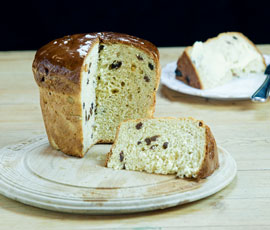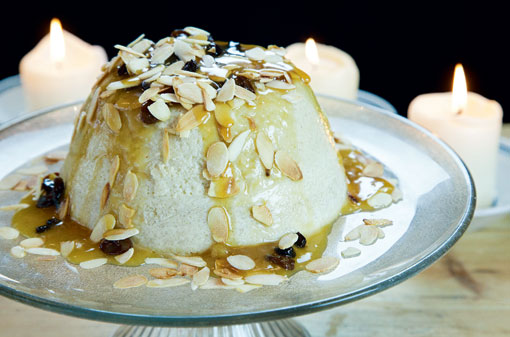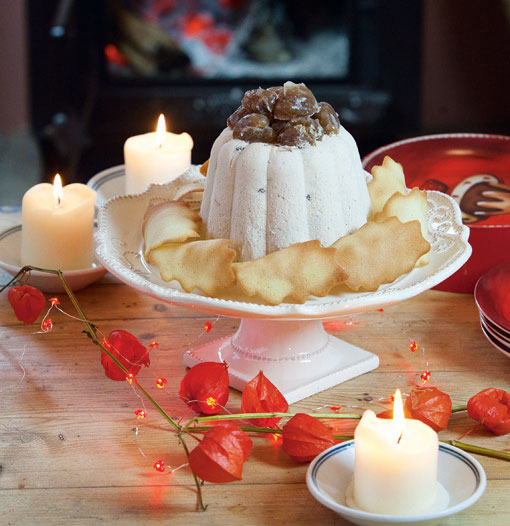Christmas puddings

Fingers on buzzers and no conferring for your Christmas starter for ten.
What links a Russian diplomat who negotiated the Treaty of Paris after the Crimean War, the diaries of Samuel Pepys and a poor baker from Milan who had a pretty daughter with whom a nobleman fell in love?
No, I wouldn’t have known the answer either had I not done the research for this month’s recipes, which provide the link – two puddings and a speciality bread. Nesselrode is the name given to various cooked dishes and pastries all containing chestnut purée and dedicated to Count Nesselrode (the Russian diplomat) of which Nesselrode pudding is the best known.
Created by his head chef, it consists of custard cream mixed with chestnut purée, candied fruit, currants, sultanas and whipped cream and it reminds me of a Christmas pudding ice cream.
In Samuel Pepys’ diary he recalls having eaten a particularly good “shaking pudding” although the recipe I’ve used is for a “quaking pudding” and both names refer to its wobbly consistency, which is similar to the centre of a very soft bread and butter pudding.
This spicy breadcrumb custard is meant to be eaten cold, but I think it’s better served warm with this sweetened white wine sauce.
According to legend, Tonio was the baker from Milan who, because he couldn’t afford a dowry for his daughter to marry her nobleman, provided all the ingredients to make an excellent bread instead and this pana (bread) de Tonio became known as Panettone.
A traditional Christmas fare, this bread is also eaten for breakfast with coffee and sometimes served as a dessert accompanied by liqueur wine.
So there you have three alternatives to Christmas pudding – but whatever you’re eating over the festive period have a merry Christmas and a happy New Year.
Panettone
Serves 6-8
- 300g (10½oz) strong white bread flour
- 100ml (3½fl oz) milk
- 5g (¼oz) salt
- 25g (1oz) yeast
- 50g (2oz) light brown sugar
- ½ level teaspoon mixed spice
- 75g (3oz) mixed fruit with peel
- 1 egg
- 50g (2oz) butter
- 1 teaspoon vanilla extract
- Honey for glazing
Preheat oven to 220C (425F, gas mark 7). Warm milk and dissolve yeast and a pinch of sugar in it. Warm flour and make a well in the centre. Melt the butter and put this in the well with the sugar, salt, spice, fruit, vanilla and egg. Mix together; add the yeast/milk mix as you go. When it has formed a dough, put it in a warm place to prove. When it has doubled in size knead the dough on a floured surface until smooth. Place it in a tin and put in a warm place to prove again. When it has doubled in bulk place in oven for 20-30 minutes; brushing with honey produces a sticky crust.

Nesselrode Pudding
Serves 6-8
- 125g (4½oz) tinned chestnut purée (unsweetened)
- 50g (2oz) candied peel
- 40g (1½oz) glacé cherries, cut in quarters
- 40g (1½oz) Maraschino cherries, cut in quarters
- 50g (2oz) currants
- 50g (2oz) sultanas
- 110ml (4fl oz) Madeira
- 1 tablespoon Maraschino liquid from the cherry jar
- 2 leaves of gelatine
- 500ml (17fl oz) whipping cream
- 500ml (17fl oz) milk
- 5 egg yolks
- 125g (4½oz) caster sugar
- Marron glacé to decorate
Soak all the fruit, including the cherries, in the Madeira and Maraschino juice overnight. Soak the gelatine leaves in cold water for about 5 minutes. Whisk together the egg yolks and sugar until pale. Bring the milk to the boil and whisk into the egg yolks and sugar. Return the mixture to the pan and cook until it thickens. Do not allow it to boil or it will curdle. Stir in the drained gelatine and allow it to melt into the custard. Strain the mixture through a fine sieve. Mix the chestnut purée into the custard followed by the fruit and alcohol. Chill well. Whip the cream until it is just holding its shape and fold into the custard. Turn the mixture into a decorative mould and freeze. To serve, turn out and decorate with whipped cream, marron glacé and your favourite ice cream biscuits or Amaretti biscuits.

Quaking Pudding
You will also need: 1 litre (2 pint) basin
Serves 6-8
- 300ml (10fl oz) milk
- 300ml (10fl oz) double cream
- 1 lemon, rind only
- Some grated nutmeg and ¼ teaspoon cinnamon
- 110g (4oz) fresh white breadcrumbs
- 75g (3oz) ground almonds
- 110g (4oz) caster sugar
- Pinch of salt
- 4 eggs
- Butter for greasing
- Toasted flaked almonds for decoration
- For the sauce:
- 100ml (3½fl oz) white wine
- 50g (2oz) caster sugar
- 50g (2oz) sultanas
- 10g (½oz) mixed peel
- 50ml (2fl oz) double cream
- 40g (1½oz) butter
- 1 tablespoon Amaretto
Bring the milk and cream to the boil with the grated lemon rind and spices. In a bowl, mix together the breadcrumbs, ground almonds, sugar and salt. Make a well in the centre and break in the eggs. Start mixing the eggs with the dry ingredients and then add the milk and cream mixture. Butter the basin and pour in the mixture, steam gently for 2 hours. Allow to cool to room temperature. To make the sauce: Place the wine, sugar and fruit into a saucepan and simmer until the sultanas become plump. Pour in the cream and bring to the boil. Add the butter a little at a time while stirring. Finally add the Amaretto. Allow to cool. To serve the pudding: Turn the pudding out on to a dish and spoon the sauce over. Scatter with toasted almonds.
